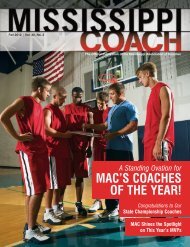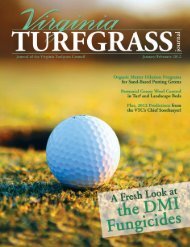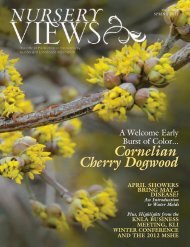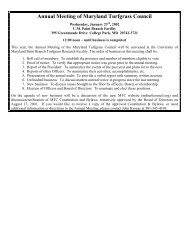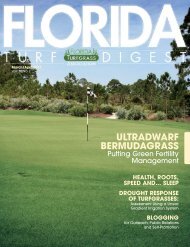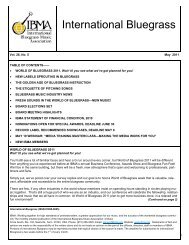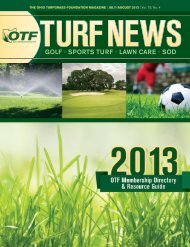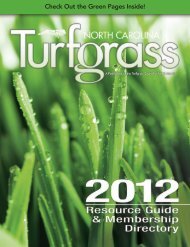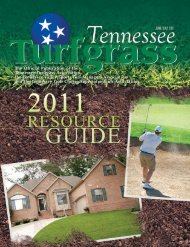January/February 2008 - Powered By The Paginator
January/February 2008 - Powered By The Paginator
January/February 2008 - Powered By The Paginator
You also want an ePaper? Increase the reach of your titles
YUMPU automatically turns print PDFs into web optimized ePapers that Google loves.
<strong>January</strong>/<strong>February</strong> <strong>2008</strong><br />
VOL. 25/NO. 1
Official Journal of the Florida Turfgrass Association<br />
table of contents<br />
<strong>January</strong>/<strong>February</strong> <strong>2008</strong><br />
VOL. 25/NO. 1<br />
Cover Story<br />
How to Overcome Challenges<br />
in the Multicultural Workplace<br />
10<br />
Management Skills<br />
Is Worker’s Compensation<br />
the Answer to Your<br />
Sick Time Ills<br />
16<br />
Focus on the Future<br />
Meet Tomorrow’s Turfgrass<br />
Leaders Today<br />
20<br />
More Features<br />
Business Matters<br />
How to Become a Level 5 Manager ...................................................................... 22<br />
News from the FTGA<br />
FTGA Unveils Updated Interactive Web Site ...................................................... 26<br />
Departments<br />
President’s Message ...................................................................................................... 6<br />
From the Executive Director ........................................................................................ 8<br />
Welcome New FTGA Members .................................................................................... 9<br />
Index of Advertisers .................................................................................................. 30<br />
EDITOR-IN-CHIEF Darren J. Davis<br />
PUBLISHER Leading Edge Communications<br />
MANAGING EDITOR MJ Plaster<br />
www.ftga.org<br />
<strong>The</strong> Florida Turfgrass Association (FTGA)<br />
serves its members in the industry through<br />
education, promotion and representation.<br />
<strong>The</strong> statements and opinions expressed<br />
herein are those of the individual authors<br />
and do not necessarily represent the views<br />
of the association, its staff, or its board of<br />
directors, Florida Turf Digest, or its editors.<br />
Likewise, the appearance of advertisers, or<br />
FTGA members, does not constitute an<br />
endorsement of the products or services<br />
featured in this, past or subsequent issues of<br />
this bimonthly publication. Copyright ©<strong>2008</strong><br />
by the FTGA. Florida Turf Digest, is published<br />
bimonthly. Subscriptions are complimentary<br />
to FTGA members. POSTMASTER: Send<br />
change of address notification to FTGA, 37<br />
North Orange Avenue, Suite 755, Orlando, FL<br />
32801. Postage guaranteed. Presorted standard<br />
postage is paid at Franklin, TN. Printed in the<br />
U.S.A. Reprints and Submissions: Florida Turf<br />
Digest, allows reprinting of material published<br />
here. Permission requests should be directed to<br />
the FTGA. We are not responsible for unsolicited<br />
freelance manuscripts and photographs.<br />
Contact the managing editor for contribution<br />
information. Advertising: For display and<br />
classified advertising rates and insertions, please<br />
contact Leading Edge Communications, LLC,<br />
206 Bridge Street, Franklin, TN 37064,<br />
(615) 790-3718, Fax (615) 794-4524.<br />
Cover photo courtesy of Darren J. Davis.<br />
4 florida turf digest • january/february <strong>2008</strong>
President’s Message<br />
A Piece of the<br />
Perpetual “Duich Pie”<br />
<strong>By</strong> Darren J. Davis, FTGA President<br />
W<br />
ith the hectic pace of our world, the days tend<br />
to merge, and the small details fade from<br />
our recollection. However, I vividly recall<br />
my induction into this terrific profession<br />
as if it were yesterday. It was an early September morning<br />
in 1989, and after a lengthy application and acceptance<br />
process and a subsequent year of nail biting eagerness,<br />
one of the most anticipated days of my life finally arrived<br />
— my first day of classes in the two-year certificate program<br />
in golf course turfgrass management at <strong>The</strong> Pennsylvania<br />
State University. However, what I and the other 30 eager<br />
turf students did not anticipate, and to be honest were<br />
shocked by, was our first lecture.<br />
It was no accident that the first class meeting of the program<br />
was taught by Dr. Joseph Duich, the famed turfgrass professor,<br />
who brought the Penn State turf program to international<br />
prominence. Regardless of where we had trained, each student<br />
in attendance that day was well aware that the person addressing<br />
us helped develop Penncross bentgrass in 1954, and later<br />
released Penneagle (1978) and Pennlinks (1986) bentgrasses,<br />
all of which are found in abundance around the world. In<br />
all of our minds, Dr. Duich was a “turf-god” and most of us<br />
had traveled a great distance to be enlightened and educated<br />
in his forte, turfgrass.<br />
In that first day, after a brief introduction, we all watched<br />
in slight bewilderment as Dr. Duich turned his back to the<br />
class and drew a large circle on the chalk board. He remarked,<br />
“Think of this circle as a pie.” He then extracted a small slice<br />
of the “pie” by drawing a triangle adjacent to the circle. In the<br />
triangle, he wrote the word “turf.” <strong>The</strong>n on the remaining<br />
90 percent of the circle, he wrote the word “people.” He<br />
turned to face the class, paused for effect and proceeded<br />
to tell us, “Most of you are sitting out there expected me to<br />
provide you with the agronomic knowledge to manage a<br />
world class golf course.” He continued, “Unfortunately what<br />
you will learn about turfgrass over the next two years will<br />
only account for a small fraction, maybe 10 percent of what<br />
your eventual job description will entail.” Again, after a<br />
noticeable pause and a gaze at the blank stares he was<br />
receiving, he concluded with, “Just like you, many of your<br />
predecessors sat in those chairs with the same look on their<br />
face; however, trust me when I tell you that each of you will call<br />
me within five years and tell me how accurate my statement is.”<br />
I have told the story of the “Duich Pie” countless times,<br />
and it is a true story. True to his assertion, I was one of those<br />
individuals who later called this wise man that I am blessed<br />
to call a friend and told him how right he was that day. For<br />
the record, it took me less than two years to make that<br />
phone call! It is rare that I encounter a manager in our<br />
profession that disagrees with the Duich Pie <strong>The</strong>ory.<br />
Regardless of the type or location of the turfgrass we are<br />
responsible for maintaining, as turfgrass managers, a major<br />
component of our success rests on our ability to hire, train,<br />
lead, motivate, inspire and encourage our staff. Unfortunately,<br />
as illustrated in the above story, people management is not<br />
something that can be taught easily or learned in a short<br />
period of time. To add further complication, most would<br />
conclude that people management is both an art and a<br />
science. Part of the art is making people more effective than they<br />
would have been without you. <strong>The</strong> science is in how you accomplish<br />
that task.<br />
<strong>The</strong> science or the mechanics of people management<br />
varies. Personally, when I am asked for guidance or advice,<br />
I relate a lesson learned at a seminar I attended 15 years ago.<br />
<strong>The</strong> take-home message from that seminar is one with<br />
which I still concur and have attempted to instill in others.<br />
<strong>The</strong> entire seminar centered on managing people with the<br />
premise of keeping four main concepts in the forefront of<br />
your actions. <strong>The</strong> four concepts are fair, firm, consistent and<br />
documentation. I have found that while people management<br />
is very much an art, and I continue to hone my skills daily,<br />
when I have managed people in a fair, firm and consistent<br />
manner and documented things when necessary, I have<br />
been successful.<br />
I relay the preceding story and thoughts to you for two<br />
reasons. First, because I believe passionately in the lesson<br />
taught to me close to 20 years ago by Dr. Duich. Second,<br />
because as you will see in this issue of the Florida Turf Digest,<br />
we have chosen to concentrate on the theme: the business<br />
of people management. ❂<br />
6 florida turf digest • january/february <strong>2008</strong>
Florida Turf Digest is the<br />
official publication of the<br />
Florida Turfgrass Association<br />
37 North Orange Avenue<br />
Suite 755<br />
Orlando, FL 32801<br />
(800) 882-6721<br />
Fax: (407) 843-3285<br />
E-mail: info@ftga.org<br />
www.ftga.org<br />
Published by<br />
Leading Edge Communications<br />
206 Bridge Street<br />
Franklin, TN 37064<br />
(615) 790-3718<br />
Fax: (615) 794-4524<br />
E-mail: info@leadingedge<br />
communications.com<br />
NEED A LIFT<br />
• EZ Mount System • 3-Point safety system<br />
• Ready to use in less than 60 seconds<br />
305-696-3500 CALL RAMONE (en Español)<br />
954-971-9440<br />
ASK FOR DOMINIC<br />
10 Locations<br />
throughout Florida<br />
ringlift.com<br />
SALES • SERVICE • RENTALS • PARTS<br />
FTGA Executive Director<br />
Casey Wohl Pace<br />
E-mail: casey@ftga.org<br />
FTGA Marketing & Events Coordinator<br />
Heather Russo<br />
E-mail: heather@ftga.org<br />
FTGA EXECUTIVE COMMITTEE<br />
President<br />
Darren J. Davis<br />
Olde Florida Golf Club<br />
(239) 353-4441<br />
darrenjdavis@aol.com<br />
Vice President<br />
Todd J. Himelberger<br />
DuPont Professional Products<br />
(941) 685-6793<br />
todd.j.himelberger@usa.dupont.com<br />
Secretary/Treasurer<br />
Gregory A. Pheneger<br />
John’s Island Club<br />
(772) 231-1700<br />
gregp@johnsislandclub.org<br />
Immediate Past President<br />
Jay H. McCord<br />
GreenTechnologies, LLC<br />
(904) 502-4695<br />
jaymccord07@aol.com
From the Executive Director<br />
Commissioner of Agriculture<br />
CHARLES H. BRONSON<br />
Addresses Critical Turfgrass Issues<br />
<strong>By</strong> Casey Wohl Pace, FTGA Executive Director<br />
On<br />
September 14, Florida Commissioner of Agriculture,<br />
Charles H. Bronson, provided closing<br />
remarks at the 55th Annual Florida Turfgrass<br />
Association Conference & Show at the Hyatt<br />
Regency Coconut Point Resort & Spa in Bonita Springs.<br />
Bronson spoke on the Trade Show floor and discussed issues<br />
critical to the Florida turfgrass industry, such as the Florida Consumer<br />
Fertilizer Task Force, water, labor and pests and diseases.<br />
We were delighted to have Commissioner Bronson attend the<br />
FTGA Conference & Show this year. With turfgrass's increasing<br />
prominence as a key Florida agricultural crop, it's very important<br />
for FTGA members to be informed and educated on statewide<br />
issues from Florida's top agricultural official.<br />
In an effort to continue that dialogue and share the Commissioner’s<br />
views with Florida Turf Digest readers, I was able to<br />
ask the Commissioner the following questions in October.<br />
Below are his responses regarding important issues the turfgrass<br />
industry faces, as well as the future outlook.<br />
Q:<br />
What is the biggest issue facing the Florida turfgrass<br />
industry today<br />
<strong>The</strong> turfgrass industry, like the rest of Florida’s $97 billiona-year<br />
agriculture industry, is facing a number of pressing<br />
A:<br />
issues. <strong>The</strong>y include pest and disease problems that threaten virtually<br />
everything that we grow, pesticide and fertilizer use, and the availability<br />
of water. None of those issues is insurmountable, and I’m confident<br />
that the industry will meet those challenges and prosper.<br />
Q:<br />
What do you see as an outcome of the Florida Fertilizer<br />
Consumer Task Force<br />
In my judgment, I think that we’ll likely see the adoption of Best<br />
A: Management Practices (BMPs) governing the use of fertilizers<br />
near water bodies. I believe that it will be critical that all turfgrass industry<br />
professionals comply with the standards adopted to demonstrate the<br />
industry’s responsiveness to helping protect the environment.<br />
Q:<br />
How will water issues impact Florida turfgrass in<br />
the future<br />
To some extent, it will depend on the length and severity of the<br />
A: current drought conditions we find ourselves in. While we’ve<br />
seen decent amounts of rainfalls in most regions of Florida during the<br />
summer, we’re still below normal levels for the year in many, if not<br />
most, parts of the state.<br />
Under any circumstances, I think there will be increasing competition<br />
for water between agribusiness and residents — even between businesses<br />
and agriculturalists growing different crops or commodities. I believe we<br />
will have to enhance conservation efforts and devise better methods of<br />
storing rainwater.<br />
Q:<br />
What can the industry expect with regards to<br />
available labor<br />
Because of the rancor and politics that have arisen over<br />
A: immigration reform, this has become a very difficult issue<br />
— and one that Florida cannot solve on its own. A solution, whether<br />
in the form of comprehensive immigration reform or even an Ag Jobs<br />
bill, unfortunately, has been delayed. We have and will continue to<br />
press Congress and the Administration for a rational policy that<br />
would assure the availability of an adequate work force. In the<br />
meantime, Florida could sustain significant economic losses in the<br />
turfgrass industry, dairy industry, fruit and vegetable industry<br />
and nurseries.<br />
Q:<br />
Where do you see the Florida turfgrass industry<br />
in 10 years<br />
I believe the industry’s future is bright. Florida continues<br />
A: to be at or near the very top in terms of attracting new<br />
residents, and these newcomers need lawns, golf courses and other<br />
recreational areas. I would add that as farm acreage contracts with<br />
the continuing urbanization of Florida, not only the new homes but<br />
the office parks, commercial developments and recreational areas that<br />
are coming will all need plenty of green grass. In fact, there are few,<br />
if any, sectors of our agricultural industry that are better positioned<br />
for the future than yours. ❂<br />
8 florida turf digest • january/february <strong>2008</strong>
Welcome New FTGA Members!<br />
Adam Varney<br />
Aerification Plus/Almar<br />
Brian Bretz<br />
UAP Professional Products<br />
Clark Smith<br />
JC Farm LLC<br />
Daniel Bott<br />
UAP Professional Products<br />
Dave Peterson<br />
Diligent Lawn & Pest Control, Inc.<br />
Ivana Montague<br />
Diligent Lawn & Pest Control, Inc.<br />
Jason Narwold<br />
Wyndemere Country Club<br />
Michael Handlin<br />
City of Orlando<br />
Nick Czerkies<br />
Walt Disney World<br />
Paul Lopez<br />
Florida Institute of Technology<br />
Phillip Hisey<br />
On Top of the World<br />
Richard Hyatt<br />
Manatee County<br />
Ryan McKuhen<br />
Jupiter Island Club<br />
Salvatore Yanello<br />
Hometown Pest Control, Inc.<br />
Sean M. McNerney<br />
City of Coconut Creek<br />
Steven Rodriguez<br />
<strong>The</strong> Preserve Golf Club @ Tara<br />
Tiffany Bispham<br />
Bayside Sod, Inc.<br />
Timothy L. Cornell<br />
City of Orlando<br />
William A. Dabney<br />
International Golf Maintenance, Inc.<br />
William E. Hatfield<br />
Bill Hatfield Enterprises<br />
William Lambert<br />
Manatee County<br />
To renew your FTGA membership or invite<br />
someone to join the FTGA online or download<br />
the Membership Application, go to<br />
http://www.ftga.org and click Membership.<br />
FTGA Directors<br />
Jan Bel Jan<br />
Fazio Golf Course Designers, Inc.<br />
(561) 746-4539<br />
j19bel@aol.com<br />
Robert Bittner, CGCS<br />
<strong>The</strong> Club at Pelican Bay<br />
(239) 597-2244<br />
bobcpb@aol.com<br />
Lee Bloomcamp<br />
Syngenta Professional Products<br />
(352) 495-3405<br />
lee.bloomcamp@syngenta.com<br />
Charlie Campbell<br />
(813) 969-4462<br />
campgolf3@verizon.net<br />
Armando Campos<br />
Liquid Ag Systems<br />
(407) 682-6100<br />
acampos@dfcinc.net<br />
Mac C. Carraway<br />
SMR Farms<br />
(941) 708-0342<br />
mac.carraway@smrfarms.com<br />
David Dymond<br />
H & H Sod Company, Inc.<br />
(407) 892-2024<br />
dave@hhsod.com<br />
William T. Hiers, CGCS<br />
<strong>The</strong> Old Collier Golf Club<br />
(239) 593-8522<br />
thiers@theoldcolliergc.com<br />
John Mascaro<br />
Turf-Tec International<br />
(850) 580-4026<br />
john@turf-tec.com<br />
Jon McDowell<br />
FMC Corporation<br />
(863) 709-1533<br />
jon_mcdowell@fmc.com<br />
Mickey Nolen<br />
Nozzle Nolen, Inc.<br />
mlmd1760@aol.com<br />
(561) 844-3544<br />
Steve Pruitt<br />
City of Winter Haven<br />
(863) 291-5745<br />
spruitt@mywinterhaven.com<br />
Matthew R. Taylor, CGCS<br />
Royal Poincianna Golf Club<br />
(239) 261-4987<br />
matt@rpgolfclub2.com<br />
Bruce Weeks<br />
Wesco Turf, Inc.<br />
(941) 377-6777<br />
bruce.weeks@wescoturf.com<br />
Stacie Zinn<br />
Environmental Turf<br />
(239) 774-1293<br />
stacie@environmentalturf.com<br />
florida turfgrass association • www.ftga.org<br />
9
Cover Story<br />
10 florida turf digest • january/february <strong>2008</strong>
OVERCOMING<br />
CHALLENGES<br />
in Working with a Multicultural Staff<br />
<strong>By</strong> Mariale Uria, CCM, CultureLinks Consulting, LLC<br />
<strong>The</strong><br />
U.S. Census Bureau estimates that<br />
in the state of Florida, 19.8 percent<br />
of the population is of Hispanic<br />
origin. This number is about five percent higher than<br />
the national average. Correspondingly, we see more<br />
immigrants in our workforce, particularly in clubs, golf<br />
courses and other service-related industries. Hispanic<br />
workers are currently concentrated in the central and<br />
southern parts of the state, yet more and more we see<br />
them scattering into communities that had not seen<br />
this type of cultural diversity before.<br />
In working in clubs and with golf course superintendents,<br />
I have found that certain practices, when<br />
implemented effectively, assist department heads in<br />
overcoming challenges that they experience when<br />
hiring and working with a multicultural staff. <strong>The</strong><br />
lessons learned, however, apply universally to<br />
workplaces employing multicultural staffs and<br />
especially to workplaces in the turfgrass industry.<br />
We should start by looking at some points to keep<br />
in mind when working with any culturally diverse staff,<br />
regardless of origin:<br />
• Not all cultures and people assimilate into the<br />
American workforce in the same way or at the<br />
same pace.<br />
• For most, English is their second language.<br />
And, learning a second language, particularly<br />
as an adult, is not an easy task.<br />
• In reference to Hispanics, remember that<br />
“Hispanic” is not a race, but a culture, and<br />
within this culture, we find a very diverse<br />
group. For example, don’t assume that all of<br />
your Hispanic employees come from Mexico.<br />
• With any predominant culture in your workforce,<br />
get to know a little bit about them. <strong>The</strong> more you<br />
understand their unique beliefs and values, the<br />
easier it will be to manage them.<br />
Hiring and managing a multicultural staff<br />
In a perfect world, all who choose to immigrate to<br />
America would enroll in English as a second language<br />
class. Immigrants would choose to assimilate into<br />
American society, both socially and economically. In<br />
this perfect world, your company would not have to<br />
adapt to other cultures; instead, those cultures would<br />
adapt to you. However, in today’s workplace, the reality<br />
is not what is envisioned in that perfect world, rather it<br />
is a place in which different cultures must learn how to<br />
work together — as a consolidated unit. <strong>The</strong> cultural<br />
differences might be great and varied, but the end<br />
result must be a united, cohesive product.<br />
Following are some suggestions on the employee<br />
process for any organization when hiring and<br />
managing a culturally diverse staff. Using Hispanics<br />
as the example, these practices could apply to any<br />
dominant culture within your geographical area.<br />
• During the hiring process, present job descriptions<br />
and company expectations written in proper<br />
Spanish. Consider using an interpreter if you<br />
are hiring for positions in which workers are<br />
not required to have good English skills.<br />
• If you do not have an employee orientation<br />
process, consider putting one in place. This is<br />
very effective in helping all employees familiarize<br />
themselves with your company, its history, company<br />
philosophy, and overall goals and objectives.<br />
florida turfgrass association • www.ftga.org<br />
11
Cover Story<br />
Through this process, you will also be able to set the<br />
teamwork expectations for your organization.<br />
• Should you not have a bilingual HR person in your organization,<br />
place a bilingual assistant, supervisor or administrative staff<br />
member in those departments where you have a concentration<br />
of Hispanic employees.<br />
• If the workforce within your company has a significant number<br />
of little or non-English speaking employees, translate your<br />
employee forms and other necessary company documents<br />
into Spanish or other predominant language.<br />
• Refrain from using same-level co-workers or peers as<br />
interpreters during employee counseling sessions.<br />
Hire an interpreter if necessary, or ask a neighbor company<br />
with a bilingual HR or administrative staff member for assistance,<br />
instead. This could save you potential legal headaches.<br />
• Create a dialogue with your multicultural staff. <strong>By</strong> doing<br />
this, you will also educate your staff on the management and<br />
communication practices that work best in your organization.<br />
Hispanics generally come from societies where authority<br />
is not really questioned; therefore, they may refrain from<br />
telling you about faulty equipment or injuries, etc. To<br />
avoid this, use meetings and other venues to give them the<br />
opportunity to give suggestions and feedback. <strong>The</strong> front line<br />
people generally have first-hand knowledge of the challenges<br />
in their departments. Use your interpreters to maximize and<br />
encourage two-way communication. This alone, will create<br />
good faith among your Hispanic workers.<br />
• Reduce the language barrier. Invest in Vocational English as a<br />
Second Language (VESL) classes for your staff. In addition,<br />
consider Spanish classes for your managers. Learning basic<br />
Spanish, specific to the work setting, could result in communicating<br />
essential safety practices, job expectations and procedures.<br />
• In reference to clubs, promote “club acculturization.” Most<br />
clubs base their foundation on the fact that they are familyoriented<br />
environments with high standards to ensure their<br />
members’ needs are met. Hispanics have strong views on the<br />
importance of family; and, regardless of differences in culture,<br />
Hispanics can relate to the values of family. Use this correlation<br />
in your training programs, employee programs and communication<br />
of the club’s goals and mission to help your Hispanic<br />
employees understand the importance of living their club’s<br />
culture through their work performance.<br />
Finally, there are some possible misconceptions regarding<br />
the Hispanic employee that I believe are important to note. First,<br />
though there are distinct differences among the Hispanic culture<br />
(for example, Mexican vs. Puerto Rican vs. Cuban, etc.), the notion<br />
that they cannot work together is one based on personalities more<br />
than on cultural differences. Second, though it is true that<br />
12 florida turf digest • january/february <strong>2008</strong>
the immigrant workers’ main objective in coming to the U.S.<br />
is for monetary reasons, it is generally not true that they<br />
will leave you for just a few cents more to go down the street.<br />
Like with any employee, their reasons for leaving are usually<br />
based on differences of opinion or not getting along with<br />
their supervisors or peers. It is up to managers to identify<br />
the root of any problems or conflicts among their staff. That<br />
said, it is important for managers to set the tone of their work<br />
environment. <strong>By</strong> creating and fostering positive environments<br />
where cultural and personal differences are respected, managers<br />
are exemplifying what the American workforce is all<br />
about. <strong>The</strong>refore, educating their staff on how to work within<br />
a multicultural workforce reduces the manager’s time spent<br />
on resolving employee conflicts and leaves more time to<br />
concentrate on achieving the overall goals of the company.<br />
<strong>The</strong>re are many individual circumstances and challenges<br />
that each company faces when it comes to its multicultural<br />
staff. Thankfully, there are just as many solutions, programs,<br />
procedures and incentives that can be applied, based on<br />
each specific organization’s needs. In working with different<br />
managers, we have utilized a wide variety of programs, specific<br />
to their needs to bridge the cultural and performance-related<br />
gaps. Through employee roundtables, focus groups, training<br />
sessions and several less formal settings like meeting facilitation<br />
and discussions, we have provided these department<br />
heads with invaluable feedback that has allowed them to<br />
coach their assistants and tweak their own management styles<br />
to best work with the diversity of their staffs.<br />
<strong>The</strong> results of this strategy include:<br />
• More effective and cohesive work groups<br />
• Less conflict<br />
• Lower turnover rate<br />
• More engaged and committed employees<br />
• Better administrative procedures, such as proper notice<br />
on resignations, requests for time off, sick day notices, etc.<br />
As more managers learn and understand how to best<br />
work with these cultural differences, the less transient and<br />
more productive their staffs have become. <strong>The</strong>se are some<br />
of the ways in which organizations have found effective<br />
methods in overcoming challenges in a changing workforce. ❂<br />
florida turfgrass association • www.ftga.org<br />
13
Management Skills<br />
Why is SICK TIME<br />
COSTING YOUR COMPANY MORE<br />
THAN WORKERS’ COMPENSATION<br />
<br />
<strong>By</strong> Jeff Wharton, Environmental Compliance Specialist, American Compliance Technologies, Inc.<br />
16 florida turf digest • january/february <strong>2008</strong>
Each day, nationwide, employees<br />
are taking the liberty to use a<br />
company benefit called sick<br />
leave. <strong>The</strong> problem is they are<br />
not sick, but because they have accumulated<br />
the time, their mind-set is, “It’s<br />
mine, and I will use it whatever way I<br />
want.” Most companies don’t have a<br />
check and balance to control this type<br />
of problem. On the other hand, an<br />
employee utilizing Workers’ Compensation<br />
is usually required to see a health<br />
care professional to determine if a condition<br />
exists. We all realize that Workers’<br />
Compensation fraud happens also, but<br />
companies are losing thousands of<br />
dollars on sick leave abuse annually.<br />
<strong>The</strong> cost of sick leave<br />
Surveys show that these losses increase<br />
each year. <strong>The</strong> average cost per year is<br />
about $602 per employee, which does<br />
not include overtime for someone else<br />
to cover the missing employee, hiring<br />
temporary workers to cover deadlines,<br />
the decline in morale and lower productivity.<br />
(Employee Benefit News and HR<br />
News). Eleven U.S.-based companies<br />
were surveyed and stated that 72 cents<br />
on every dollar paid out was attributed<br />
to employee absence rather than health<br />
care and disability insurance. Sick leave<br />
abuse turns into lost dollars, and in<br />
turn, can cost the company substantial<br />
amounts of money.<br />
<strong>The</strong> carrot vs. the stick<br />
Employees who abuse sick leave are<br />
usually violating a company’s attendance<br />
policy and are the same employees<br />
who violate this policy on numerous<br />
occasions. <strong>The</strong> issue of disciplining an<br />
employee who abuses sick leave should<br />
be addressed in a written policy. If a<br />
policy does not exist, you will probably<br />
have a hard time using disciplinary<br />
action to correct the problem. Another<br />
situation that arises is that employees<br />
who use excessive sick time may have<br />
problems other than their own sickness.<br />
It may be family illness, such as children<br />
or parents.<br />
Finding the root of the problem may<br />
help cut down on abuse of sick leave. Sit<br />
down with the employee and have a conference<br />
to find out what is happening<br />
in his or her life. To cover yourself,<br />
remember to document every occurrence<br />
when a pattern arises; if it’s not<br />
in writing it didn’t happen!<br />
Some companies offer incentive<br />
programs to bribe employees not to<br />
use sick time instead of addressing the<br />
issue and taking a firm stand. This<br />
method can send the wrong message<br />
to the employee. However, requiring<br />
employees to produce a doctor’s note<br />
after two consecutive days of sick time<br />
is usually a good deterrent. Or, if sick<br />
leave abuse is proven, then loss of paid<br />
benefits is an option.<br />
<strong>The</strong> root of the problem<br />
Let’s take a look at the real problem,<br />
“Why doesn’t the employee want to<br />
be at work” Is it the lack of company<br />
policy on taking time off, or is the<br />
management style of leadership<br />
causing a drop in morale Are the<br />
employees in high stress jobs where<br />
extra time off might be justified<br />
As we address these concerns, let’s<br />
not forget about the employee who<br />
does his or her job and is at work<br />
every day. <strong>The</strong> effect of a stringent<br />
policy on sick leave may cause your<br />
good employees to come to work ill.<br />
Some company policies dealing<br />
with the amount of people allowed<br />
off for vacation at the same time can<br />
cause an increase of sick leave abuse.<br />
In other words, “If four people are<br />
allowed off on vacation and I want<br />
to be off, then guess what I’m sick.”<br />
Don’t fool yourself; it happens every<br />
day. <strong>The</strong> problem is that nothing is<br />
being done to resolve the issue. We<br />
hear all the time, “I recently brought<br />
this issue to the attention of<br />
management and the response was,<br />
‘Every department is doing this so it<br />
will be hard to discipline anyone.’”<br />
One question you should ask yourself<br />
is “What I can do to make the employee<br />
want to come to work Is it rotating<br />
job assignments, so they don’t get<br />
bored, or maybe having a lunch to<br />
honor those who achieve the goal<br />
of little to no absenteeism”<br />
This issue has been around for<br />
many years and will remain in your<br />
workplace until management takes a<br />
firm stand. As we move forward into<br />
a new year, let’s be proactive on this<br />
issue instead of reactive and formulate<br />
a sick leave policy that benefits the<br />
company and its employees. ❂<br />
florida turfgrass association • www.ftga.org<br />
17
Focus on the Future<br />
Meet the FTGA’s<br />
<strong>2008</strong><br />
SCHOLARSHIP<br />
RECIPIENTS<br />
<strong>The</strong><br />
members of the FTGA<br />
Research and Scholarship<br />
Committee are pleased to introduce the<br />
winners of the <strong>2008</strong> scholarships — the<br />
future leaders of Florida’s turfgrass<br />
industry. <strong>The</strong> winners are:<br />
<strong>By</strong> Stacie Zinn, Chair, Research<br />
and Scholarship Committee<br />
ABOVE: (L-R) Stacie Zinn, Tyler Anderson, Laurie Bland,<br />
Jason Frank, Brian Schwartz, Carole Townsend, Richard<br />
Maddox, Jay McCord.)<br />
20 florida turf digest • january/february <strong>2008</strong>
LAKE CITY COMMUNITY COLLEGE<br />
All of the Lake City Community College winning students this<br />
year are preparing for careers as a golf course superintendent.<br />
James L. Blackledge<br />
Memorial Scholarship, $1,500<br />
This award was established in 1983 in memory of James L.<br />
Blackledge. His career in the turfgrass industry included<br />
landscaping, golf course superintendent, industry sales, private<br />
business, agronomist, consultant, advisor and industry leader.<br />
Blackledge helped organize the Florida Turf Association<br />
(later changed to the Florida Turfgrass Association) and<br />
was the first recipient of the Wreath of Grass. He served<br />
two terms as President of the FTGA and was a pillar of the<br />
FTGA and the Florida turfgrass industry.<br />
Richard Maddox is from Gainesville.<br />
He is the new FTGA Student Chapter<br />
President and participated in the Golf<br />
Course Superintendents Association of<br />
America(GCSAA) Turf Bowl in Anaheim,<br />
CA. He has worked in maintenance at<br />
Southern Oaks Golf Club and interned<br />
this past summer at Reynolds Plantation.<br />
Hans Schmeisser Memorial<br />
Scholarship, $1,500<br />
This award was established in 1981 in memory of Hans<br />
Schmeisser, who emigrated from Germany to the U.S. in the<br />
1920s to develop the landscaping at Everglades City. While<br />
there, he designed and built his first course, one of the first<br />
golfing facilities in Florida. He was instrumental in establishing<br />
the first Association of Golf Course Superintendents<br />
in Florida and was one of the nation's leading golf course<br />
superintendents and designers. He served as President of the<br />
South Florida GCSA (SFGCSA), taught turfgrass management<br />
at Palm Beach Junior College and was awarded the Golf<br />
Course Superintendents Association of America (GCSAA)<br />
Distinguished Service Award posthumously.<br />
Laurie Bland is from Hollywood, FL,<br />
and is the FTGA student liaison. She<br />
participated in the GCSAA Turf Bowl<br />
in Anaheim, CA. She has worked as an<br />
assistant technician at the University of<br />
Florida golf course and interned this<br />
past summer at Doral’s Blue Monster.<br />
General Scholarship, $1,000<br />
FTGA reserves the right to award one General Scholarship to<br />
a student studying turfgrass at Lake City Community College.<br />
Carole Townsend lives in Jacksonville<br />
and has worked in maintenance<br />
at Windsor Park Golf Club in Jacksonville<br />
and at Dataw Island Club in<br />
South Carolina. She interned this<br />
past summer at Mid Pacific Country<br />
Club in Hawaii.<br />
UNIVERSITY OF FLORIDA<br />
Colonel Frank Ward Memorial<br />
Scholarship, $1,500<br />
Colonel Frank Ward presented the first award at the 10th<br />
Annual Turfgrass Management Conference. Ward, a retired<br />
army colonel, served as President of the FTGA for two terms,<br />
from 1956–1958 and as Executive Secretary from 1959–1960,<br />
when he also edited the first newsletter. In 1960, he instituted<br />
the Wreath of Grass award and later became a recipient of the<br />
award in 1963. Through Ward’s effort, the FTGA made its mark<br />
in the turfgrass industry in Florida.<br />
Tyler Anderson is from Weston, FL. Like<br />
his father, John V. Anderson, CGCS, he is<br />
pursuing a career as a golf course superintendent.<br />
Tyler earned the highest grade<br />
in his Turfgrass Culture course (96.4%),<br />
taught by Dr. J. Bryan Unruh. He participated<br />
in the turf bowls at both the 2007<br />
Sports Turf Managers Association(STMA)<br />
and GCSAA conferences, and he serves as President of the<br />
UF Turfgrass Science Club. He has worked at Weston Hills<br />
Country Club and interned this year at Atlanta Athletic Club.<br />
Max J. McQuade Memorial<br />
Scholarship, $1,000<br />
This award was adopted in memory of Max J. McQuade, a<br />
young man whose dedication to the turfgrass industry and<br />
desire to excel was an inspiration to all who knew him. He<br />
came to the Augusta National Golf Club in August 1997 as<br />
a student intern during his junior year at the University of<br />
Florida. Upon graduation, he was hired for a full-time turf<br />
grad position and quickly became an integral part of the<br />
crew and staff, working with an attention to detail and a<br />
“can-do” attitude that is vital to the industry.<br />
Jason Frank is from Deland, and he is<br />
working on his Masters thesis, Utilizing<br />
Remote Sensing Technology to Assess Stress in<br />
Turfgrass, under Dr. J. Bryan Unruh. He<br />
has interned at the TPC at Sawgrass, and<br />
he has held positions at three lawn care<br />
and nursery companies and owned his<br />
own landscape company. Jason served<br />
as facilitator for two turfgrass courses at UF and helped to<br />
prepare his fellow students for both national turf bowls by<br />
mentoring and creating a 240-page training manual.<br />
General Scholarship, $1,000<br />
FTGA reserves the right to award one General Scholarship<br />
to a student studying turfgrass at the University of Florida.<br />
Brian Schwartz is originally from Illinois<br />
and is pursuing his Ph.D. in turfgrass<br />
breeding under Dr. Kevin Kenworthy.<br />
While maintaining a 4.0 GPA, he works<br />
at the research plots in Citra and on his<br />
dissertation involving nematode screening<br />
and management of zoysiagrass. ❂<br />
florida turfgrass association • www.ftga.org<br />
21
Business Matters<br />
LEVEL<br />
How to Become a<br />
5<br />
MANAGER<br />
<strong>By</strong> Raleigh F. (Sandy) Seay, Jr., Ph.D., Seay Management Consultants<br />
One<br />
of the<br />
most<br />
influential books on management<br />
in the past several<br />
years is Good to Great, authored by widely<br />
respected management expert and teacher,<br />
Jim Collins. <strong>The</strong> book is filled with exciting<br />
and innovative ideas, and we strongly recommend<br />
it to you. Collins offers interesting<br />
observations and suggestions on how a good<br />
company can make the journey<br />
to became a great company,<br />
and then go on to sustain that<br />
greatness for an extended<br />
period of time. Having studied a variety of<br />
different companies from this viewpoint,<br />
Collins explains and illustrates the characteristics<br />
of companies who have reached<br />
this goal and provides us with check points<br />
to measure our own success.<br />
22 florida turf digest • january/february <strong>2008</strong>
Management style<br />
One characteristic of a “Good to Great” company is that it<br />
includes a specific type of management style he calls a “Level<br />
5 Manager.” According to the European Council for Building<br />
Professionals, “management style” is defined as, “an approach<br />
adopted by managers in exercising authority, encouraging<br />
participation in decision-making, motivating staff, delegating<br />
authority, communicating information and maintaining<br />
control.” Various kinds of management styles include:<br />
• Authoritarian<br />
• Hands on<br />
• Micromanagement<br />
• Delegation management<br />
• Management by memo<br />
• MBWA (management by walking around)<br />
• Getting work done through other people<br />
(as in the classic definition)<br />
Much of one’s management style has to do with personality<br />
temperament, whether one is essentially (1) a hard charging<br />
Type A, (2) a people-oriented Sanguine, (3) a consistent and<br />
stable Phlegmatic or (4) a detail oriented Perfectionist. Your<br />
personality temperament (or working style) can be identified<br />
through a variety of management assessment tools, most notably<br />
the DISC profile. If you would like to know more about the<br />
DISC profile and how it can help you and your management<br />
team, e-mail me at sandy@seay.us, and I’ll provide you with<br />
the information.<br />
Two characteristics of a Level 5 Manager<br />
According to Collins, an essential characteristic of Good to<br />
Great companies is that they are led and managed by Level<br />
5 Managers. Level 5 Managers have two basic characteristics.<br />
First, they have a healthy dose of personal humility. <strong>The</strong>y are<br />
not overcome with ego, and they direct praise and credit to<br />
other people, rather than themselves. Non-Level 5 Managers,<br />
on the other hand, tend to speak of themselves often and use<br />
the personal pronoun “I” quite a bit, as in, “I did this,” or<br />
“Look what I accomplished.” Collins cites one manager who<br />
commented, “You know, I really relate to this Rambo character;<br />
he reminds me of me.” Level 5 Managers, on the other hand,<br />
tend to deflect personal praise and speak more often of the<br />
contributions of others, but they do so as a natural part of<br />
their character, in a genuine and sincere way, and not out of<br />
false modesty. Some of the words used to describe a Level 5<br />
Manager include quiet, humble, modest, reserved, shy, gracious,<br />
mild-mannered, self-effacing and understated.<br />
Second, Level 5 Managers have an intense personal will of<br />
iron and are willing to do whatever is necessary to bring success<br />
to the company. Level 5 Managers are focused on the company,<br />
rather than themselves, they are fanatically driven toward company<br />
success and possess a ferocious, unwavering resolve.<br />
Level 5 Managers and the<br />
parable of the Window and the Mirror<br />
Level 5 Managers attribute much of their success to “luck,”<br />
and they tend to talk about luck quite a bit. <strong>The</strong>y often say,<br />
“Well, I was lucky,” and they speak of their success as a<br />
blessing or of a stroke of good fortune. This is part of the<br />
way they steer praise away from themselves and toward<br />
others. Non-Level 5 Managers, on the other hand, tend<br />
to be blamers. <strong>The</strong>y look for some one or some thing<br />
on which to blame their failures, such as the economy,<br />
the environment, an incompetent subordinate or some<br />
unexpected event. Several years ago, Thomas Harris wrote<br />
a book entitled, I’m OK, You’re OK, in which he argued<br />
that all blame is useless, a principle with which I’m sure<br />
Jim Collins would agree. Here, I’m reminded of the story<br />
of the two sales employees who were sent to China to sell<br />
shoes. <strong>The</strong> first one e-mailed back and said, “No market<br />
here, no one wears shoes, I’m coming home.” <strong>The</strong> second<br />
one e-mailed back and said, “Huge market for shoes here,<br />
no one has any, double my order.”<br />
Collins provides us with a fascinating metaphor about Level<br />
5 Managers, when he recounts the parable of the Window and<br />
the Mirror. Level 5 Managers have a Window and a Mirror.<br />
When the company is successful, they look out of the Window<br />
and give the credit for success to others. When things go wrong,<br />
they look into the Mirror accept the responsibility.<br />
Non-Level 5 Managers have a Window and a Mirror also, but<br />
they do just the opposite with them. When things go well, they<br />
look in the Mirror and give themselves the credit. When things<br />
go south, they look out the Window and blame others.<br />
How to become a Level 5 Manager<br />
Collins does not tell us how to become a Level 5 Manager,<br />
although he thinks that most managers can become one.<br />
He does say that some managers can never become Level 5<br />
Managers, and these are the ones who may need to get “off<br />
the bus,” to use his term. At Seay Management, it seems to<br />
me that the following check points might be helpful.<br />
1. Level 5 Managers have both a personal humility and<br />
an iron will. <strong>The</strong>se are personality temperament<br />
characteristics that are largely hardwired, and if a<br />
person does not possess them, he or she is unlikely<br />
to acquire them. <strong>The</strong> DISC profile can be very helpful<br />
in identifying these characteristics.<br />
2. Level 5 Managers speak a good deal of “luck” and not<br />
so much about outside factors. We can ask ourselves if<br />
our conversation includes this kind of philosophy and<br />
we can listen to our management team to see if they<br />
use these words — luck, good fortune, providence,<br />
being at the right place at the right time, etc.<br />
florida turfgrass association • www.ftga.org<br />
23
Business Matters<br />
3. Level 5 Managers are not “blamers” and tend not to<br />
assign blame to others. To the contrary, they look out<br />
of the Window during good times and give credit to<br />
others, and they look in the Mirror during times when<br />
they need to accept responsibility. For us, individually,<br />
we can examine our own management style and see to<br />
what purpose we put the Window and the Mirror, and<br />
we can check up on our management team, as well.<br />
4. Level 5 Managers would say, “Our most important<br />
assets are our good employees.”<br />
5. Level 5 Managers would have continuing management<br />
training to reinforce this philosophy.<br />
6. Level 5 Managers would hire only persons who are<br />
or who could become Level 5 Managers, as well.<br />
Socrates once commented, “<strong>The</strong> unexamined life is not<br />
worth living.” Collins’ book and his insights on Level 5 Managers<br />
give us an opportunity to examine our management lives to<br />
see where we stand on the Level 5 Continuum, and then to<br />
make plans to move forward and upward from Good to Great.<br />
If you would like a presentation on “Level 5 Management”<br />
or on Collins’ book, Good to Great, contact Sandy Seay at<br />
sandy@seay.us.<br />
Give us a call<br />
With your FTGA membership, you are entitled to call and talk<br />
with one of Seay Management’s professional consultants at any<br />
time, free of charge. When you have a human-resources question<br />
and need an answer, identify yourself as an FTGA member<br />
and ask to speak to a consultant. Call Seay Management at<br />
(407) 426-9484. ❂<br />
24 florida turf digest • january/february <strong>2008</strong>
News from the FTGA<br />
FTGA.org<br />
Guided<br />
Tour<br />
<strong>By</strong> Heather Russo, FTGA<br />
Marketing and Events<br />
Coordinator<br />
In<br />
July 2007, the Florida<br />
Turfgrass Association created<br />
a new Web site for FTGA<br />
members and turfgrass industry professionals.<br />
<strong>The</strong> Web site, www.ftga.org, now<br />
serves as a primary source of up-to-date<br />
information regarding the turfgrass<br />
industry. Follow along on your computer<br />
to explore the options listed below.<br />
ftga.org homepage<br />
From the main area of the home page<br />
(www.ftga.org), you can access FTGA<br />
and turfgrass industry news items,<br />
information on upcoming FTGA<br />
events, a calendar of FTGA and related<br />
industry events, as well as access to the<br />
member application. Joining the FTGA<br />
is easier than ever with the new online<br />
member application.<br />
<strong>The</strong> menu that runs along the left side of<br />
the screen offers access to all sections of<br />
the Web site, except those restricted to<br />
FTGA members.<br />
ftga.org online application<br />
Just below the menu, you’ll find the<br />
Member Login area that provides a<br />
host of new features, including access<br />
to exclusive benefits such as the FTGA<br />
membership directory and a printable<br />
edition of the Association’s bimonthly<br />
magazine, Florida Turf Digest — both<br />
in PDF format. Soon, the Web site will<br />
offer convenient online registrations<br />
26 florida turf digest • january/february <strong>2008</strong>
for the annual Conference &<br />
Show and the annual Regional<br />
Turf Seminars.<br />
Advertising opportunities are<br />
available for companies interested<br />
in gaining exposure in the Florida<br />
Turf Digest. For more information,<br />
click Publications on the menu on<br />
the home page.<br />
<strong>The</strong> FTGA is proud to introduce the<br />
new Web site, and we’re certain that it<br />
is an informative tool for all turfgrass<br />
industry representatives. But, this is just<br />
the beginning. We look forward to<br />
adding more features to the Web site to<br />
benefit the FTGA membership, and we<br />
continue to make incremental improvements<br />
behind the scenes to make your<br />
experience on the Web site a pleasant<br />
and informative one. ❂ ftga.org menu ftga.org member login
Active Member<br />
Name<br />
Company<br />
Title<br />
Associate Member<br />
Retired Member<br />
Work Address<br />
Membership Application<br />
____________________________________________________________<br />
____________________________________________________________<br />
____________________________________________________________<br />
____________________________________________________________<br />
City ________________________ State ___________ Zip __________<br />
Billing Address<br />
____________________________________________________________<br />
City ________________________ State ___________ Zip __________<br />
Home Address<br />
____________________________________________________________<br />
City ________________________ State ___________ Zip __________<br />
Work Phone ________________________ Fax ___________________________<br />
Home Phone ________________________ Mobile ___________________________<br />
E-mail ________________________ Web site __________________________<br />
New Member _____ Renewal _____ Referred by _______________________<br />
Payment Information<br />
* Florida Turfgrass Research Foundation is a 501(c)(3) nonprofit organization. Your voluntary research donation is tax-deductible<br />
to the extent allowed by law. No goods or services were provided in exchange for your generous voluntary research donation.<br />
Check<br />
Charge Credit Card # Total<br />
Visa<br />
Exp. Date<br />
Enclosed<br />
#_________<br />
MasterCard CCV (3 digits on back or 4 digits on front)<br />
Make check<br />
payable to FTGA<br />
Annual Membership Categories<br />
(please select one Membership Category)<br />
Persons whose residence or employment is in Florida and are<br />
actively engaged in the industry.<br />
Persons who are in or out of Florida who desire to take an active<br />
part in the Association.<br />
Retired from Active or Affiliate membership and remain an active<br />
participant in the turfgrass industry.<br />
American Express<br />
Discover<br />
Billing Zip Code<br />
Signature<br />
Member<br />
Dues<br />
37 N. Orange Avenue, Suite 755 | Orlando, FL 32801 | Phone (800) 882-6721 | Fax (407) 843-3285 | www.ftga.org<br />
Voluntary<br />
Research<br />
Donation *<br />
Total Dues<br />
&<br />
Contribution<br />
$190.00 $25.00 $215.00<br />
$190.00 $25.00 $215.00<br />
$190.00 $25.00 $215.00<br />
Affiliate Member Employees of an Active or Associate member. $90.00 $25.00 $115.00<br />
Student Member<br />
Enrolled in turf management, ornamental, horticulture or related<br />
study program.<br />
$35.00 $25.00 $60.00<br />
Select One Industry Which Describes Your Affiliation<br />
Commercial Suppliers Consultants/Architects Golf Course Mgt Landscape Lawncare<br />
Memorial/Military Nursery Growers Park/Sports Mgt Pest Control Property Mgt<br />
Retail Turf Sod Farm/Producers School/Municipal Student University/Extension
Index of Advertisers<br />
Almar/Aerification Plus ............................ 15<br />
www.aerificationplus.com<br />
Aqua-Aid, Inc. .................. Inside Back Cover<br />
www.aquaaid.com<br />
BASF ...................................................... 5<br />
www.basf.com<br />
Coastal Equipment Systems, Inc. .............. 29<br />
Florida Caterpiller<br />
Dealer Group .................... Inside Front Cover<br />
www.thecatrentalstore.com<br />
John Deere Landscapes ............................ 3<br />
www.lesco.com<br />
K-Rain Manufacturing Corp. .................... 25<br />
www.krain.com<br />
Kesmac Inc. .......................................... 14<br />
www.kesmac.com<br />
Kilpatrick Turf Equipment ........................ 18<br />
www.kilpatrick.com<br />
Monsanto .................................. Back Cover<br />
www.farmsource.com<br />
Palm Beach Country Club ...................... 18<br />
Pennington Seed .................................... 19<br />
www.penningtonseed.com<br />
Pike Creek Turf, Inc. ................................ 30<br />
www.pikecreekturf.com<br />
Ring Power Lift Trucks .............................. 7<br />
www.ringpower.com<br />
Roberts Supply, Inc. ................................ 27<br />
www.shindaiwa.com<br />
ShowTurf of South Florida, LLC ................ 29<br />
SMR Farms .............................................. 7<br />
www.smrfarms.com<br />
Southern Agricultural Insecticides, Inc. .... 30<br />
www.southernag.com<br />
<strong>The</strong> Turfgrass Group ..........................13, 24<br />
Turf Specialties, Inc. ................................ 27<br />
www.turfspecialties.net<br />
30 florida turf digest • january/february <strong>2008</strong>




